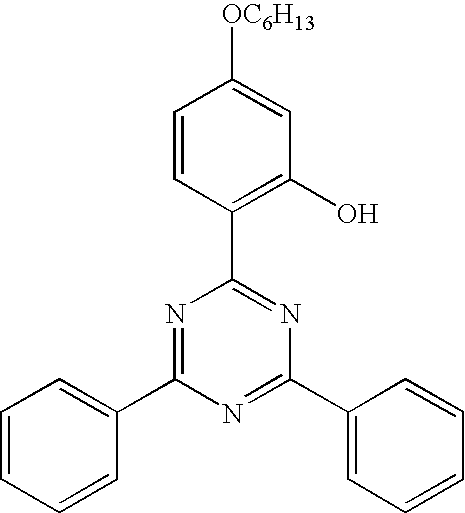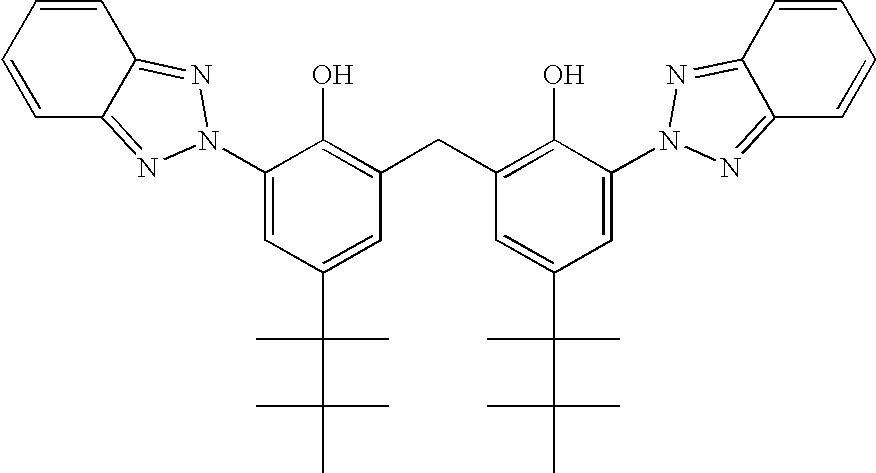Transparent, low-flammability, UV-resistant film made from a crystallizable thermoplastic, its use and process for its production
a technology of crystallization thermoplastics and uv resistance, which is applied in the field of transparent, low flammability, uv resistance films made from crystallization thermoplastics, can solve the problems of deterioration of mechanical properties, yellowing of known films, and proposal as to how to improve the uv resistance of films of this type, and plastics are very susceptible to hydrolysis. , to achieve the effect of improving the uv resistance of films, the predation process is a crystallization and a crystallization and a crystallization and a technology of a crystallization and a technology of a crystallization and a crystallization and a technology of a crystallization and a technology of a crystallization and a technology of a crystallization and a technology of a crystallization and a technology of a crystallization uv resistance and uv resistance of crystallization resistance of crystallization resistance of crystallization resistance of crystallization resistance of crystallization resistance of crystallization resistance of crystallization resistance of crystallization resistance of crystallization
- Summary
- Abstract
- Description
- Claims
- Application Information
AI Technical Summary
Benefits of technology
Problems solved by technology
Method used
Image
Examples
example 1
[0111]A transparent film of 50 μm thickness is produced, comprising polyethylene terephthalate as principal constituent, 0.2% by weight of SYLOBLOC® as antiblocking agent, 4% by weight of the organic phosphorus compound as flame retardant and 1.0% by weight of the UV stabilizer 2-(4,6-diphenyl-1,3,5-triazin-2-yl)-5-hexyloxyphenol (TINUVIN® 1577).
[0112]To obtain homogeneous distribution, 0.2% by weight of SYLOBLOC® antiblocking agent is incorporated directly into the polyethylene terephthalate (PET) when the polymer is prepared.
[0113]The polyethylene terephthalate from which the transparent film is produced has a standard viscosity SV (DCA) of 810, corresponding to an intrinsic viscosity IV (DCA) of 0.658 dl / g.
[0114]TINUVIN® 1577 UV stabilizer has a melting point of 149° C. and is thermally stable up to about 330° C. The UV stabilizer TINUVIN® 1577 is fed in the form of a masterbatch. The masterbatch is composed of 5% by weight of TINUVIN® 1577 UV stabilizer as active ingredient and ...
example 2
[0127]Coextrusion technology is used to produce a multilayer PET film having the layer sequence A-B-A and a thickness of 17 μm, B being the core layer and A being the outer layers. The core layer has a thickness of 15 μm, and each of the two outer layers, which cover the core layer, has a thickness of 1 μm.
[0128]The polyethylene terephthalate used for the core layer B is identical with the polymer of Example 1 except that it comprises no SYLOBLOC® antiblocking agent. The core layer comprises 0.2% by weight of hydrolysis stabilizer and 5% by weight of flame retardant. As in Example 1, the hydrolysis stabilizer and the flame retardant are fed in the form of a masterbatch. The masterbatch is composed of 25% by weight of flame retardant, 1% by weight of hydrolysis stabilizer and 74% by weight of polyethylene terephthalate. The hydrolysis stabilizer and the flame retardant are identical with the active ingredients used in Example 1.
[0129]The polyethylene terephthalate of the outer layers...
example 3
[0137]As in Example 2, an A-B-A film of 20 μm thickness was produced, the core layer B having a thickness of 16 μm and each outer layer A having a thickness of 2 μm.
[0138]The core layer B comprises only 5% by weight of the flame retardant masterbatch of Example 2.
[0139]The outer layers are identical with those of Example 2, except that they additionally comprise 20% by weight of the flame retardant masterbatch, used in Example 2 only for the core layer.
[0140]The polymers and the masterbatches for the core layer and the outer layers are precrystallized, predried and post-dried as in Example 1. The multi layer 20 μm film produced using coextrusion technology has the following property profile:
[0141]
Layer structureA-B-AThickness20 μmSurface gloss,(Measurement angle 20°)Side 1168Side 2163Luminous transmittance94.0%Haze2.2%Surface defects per m2none(cracks, embrittlement)Longitudinal modulus of elasticity4000 N / mm2Transverse modulus of elasticity4700 N / mm2Longitudinal tear strength180 N / ...
PUM
| Property | Measurement | Unit |
|---|---|---|
| thickness | aaaaa | aaaaa |
| luminous transmittance | aaaaa | aaaaa |
| temperatures | aaaaa | aaaaa |
Abstract
Description
Claims
Application Information
 Login to View More
Login to View More - R&D
- Intellectual Property
- Life Sciences
- Materials
- Tech Scout
- Unparalleled Data Quality
- Higher Quality Content
- 60% Fewer Hallucinations
Browse by: Latest US Patents, China's latest patents, Technical Efficacy Thesaurus, Application Domain, Technology Topic, Popular Technical Reports.
© 2025 PatSnap. All rights reserved.Legal|Privacy policy|Modern Slavery Act Transparency Statement|Sitemap|About US| Contact US: help@patsnap.com


